Northern Okinawa Including Yanbaru
The northern part of the Okinawa main island is home to a range of southwest island endemics including some endemic only to this single island. Endemic birds, reptiles, frogs, mammals, insects and plants make this a naturalist's paradise. Most birders will choose to visit during the winter and spring months.
Yanbaru 沖繩 やんばる
 Yanbaru, the northern mountainous region of Okinawa Island, is an approximately three-hour drive north of Naha, the prefectural capital. As this forested area holds several endemic species high on any visitor's list, a minimum of two nights is recommended in the area.
Yanbaru, the northern mountainous region of Okinawa Island, is an approximately three-hour drive north of Naha, the prefectural capital. As this forested area holds several endemic species high on any visitor's list, a minimum of two nights is recommended in the area.
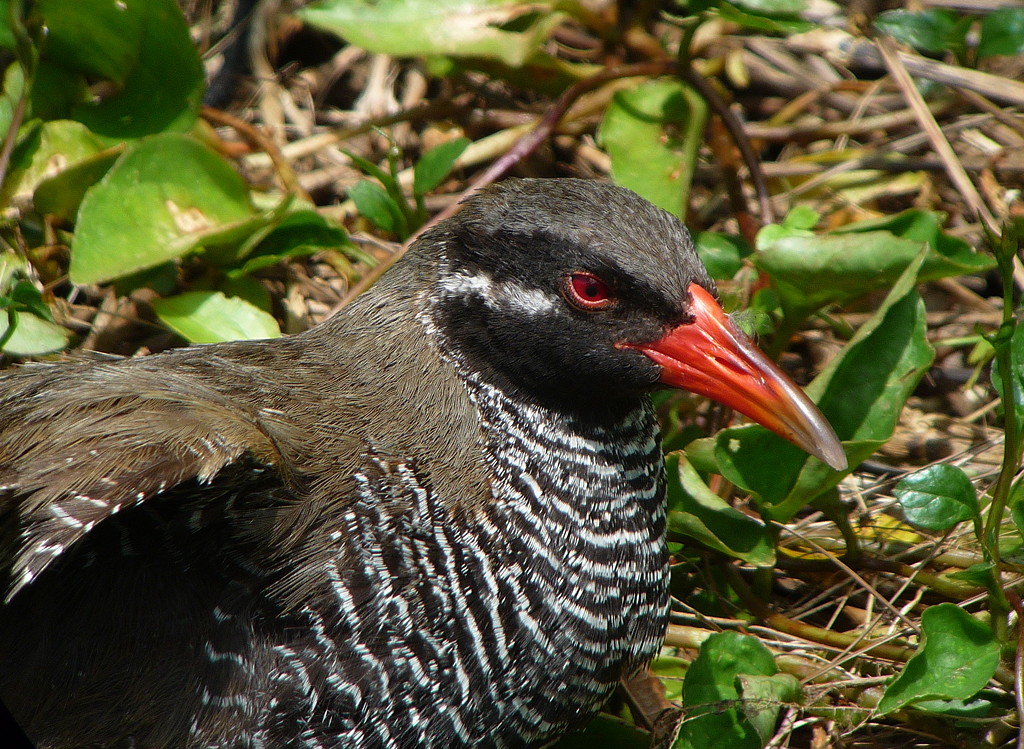 The main target birds here are the single island endemics, Okinawa Rail, Pryer's (Okinawa) Woodpecker, and Okinawa Robin. There are also Ryukyu Archipelago endemics to look for such as Ryukyu Scops Owl and Ryukyu Green Pigeon.
The main target birds here are the single island endemics, Okinawa Rail, Pryer's (Okinawa) Woodpecker, and Okinawa Robin. There are also Ryukyu Archipelago endemics to look for such as Ryukyu Scops Owl and Ryukyu Green Pigeon.
Here is a rundown on some of the sites to visit and the specialities of the area:
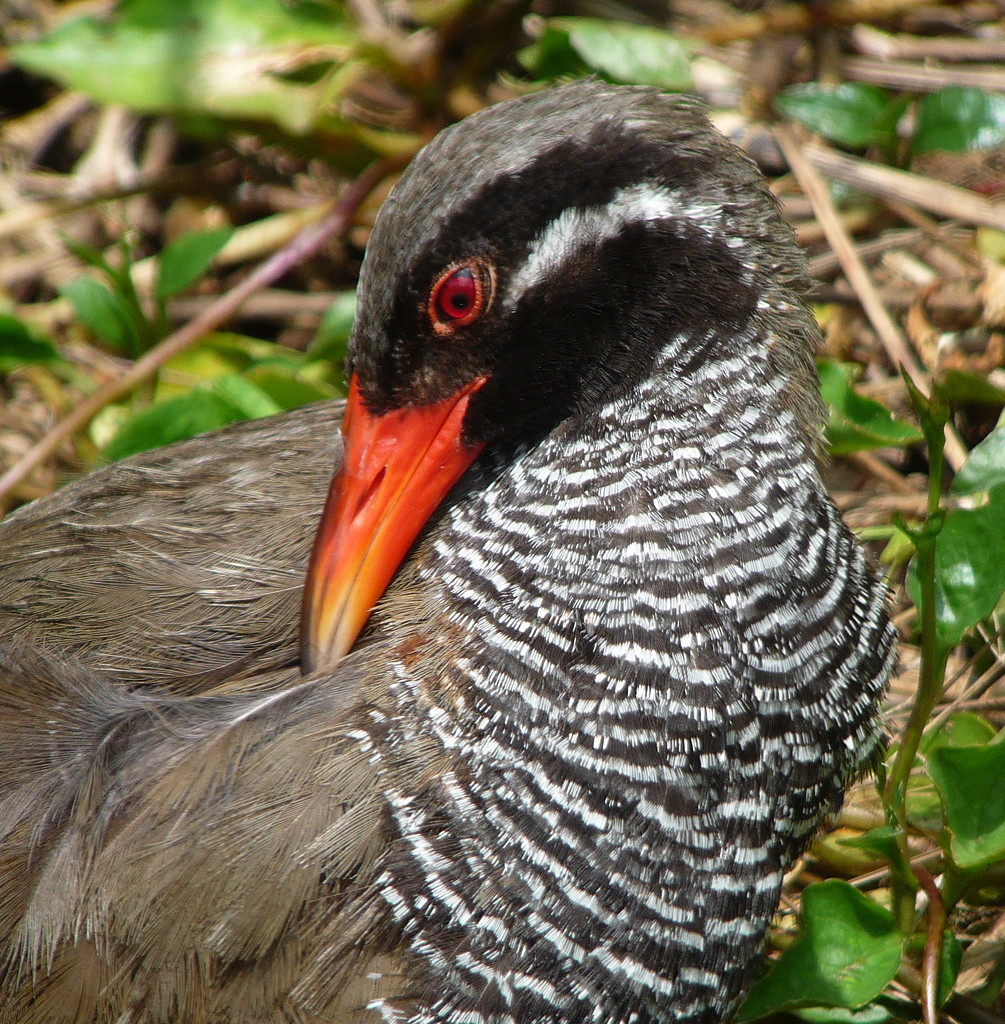 Okinawa Rail: This species is, in fact, reasonably common as birds can be seen and often heard throughout Yanbaru. The highest density appears to be in the narrow valleys, along streams and around agricultural areas mainly to the north of Route 2, which cuts across the top of the island between Yona and Ada villages.
Okinawa Rail: This species is, in fact, reasonably common as birds can be seen and often heard throughout Yanbaru. The highest density appears to be in the narrow valleys, along streams and around agricultural areas mainly to the north of Route 2, which cuts across the top of the island between Yona and Ada villages.
There are several places to check. They include:
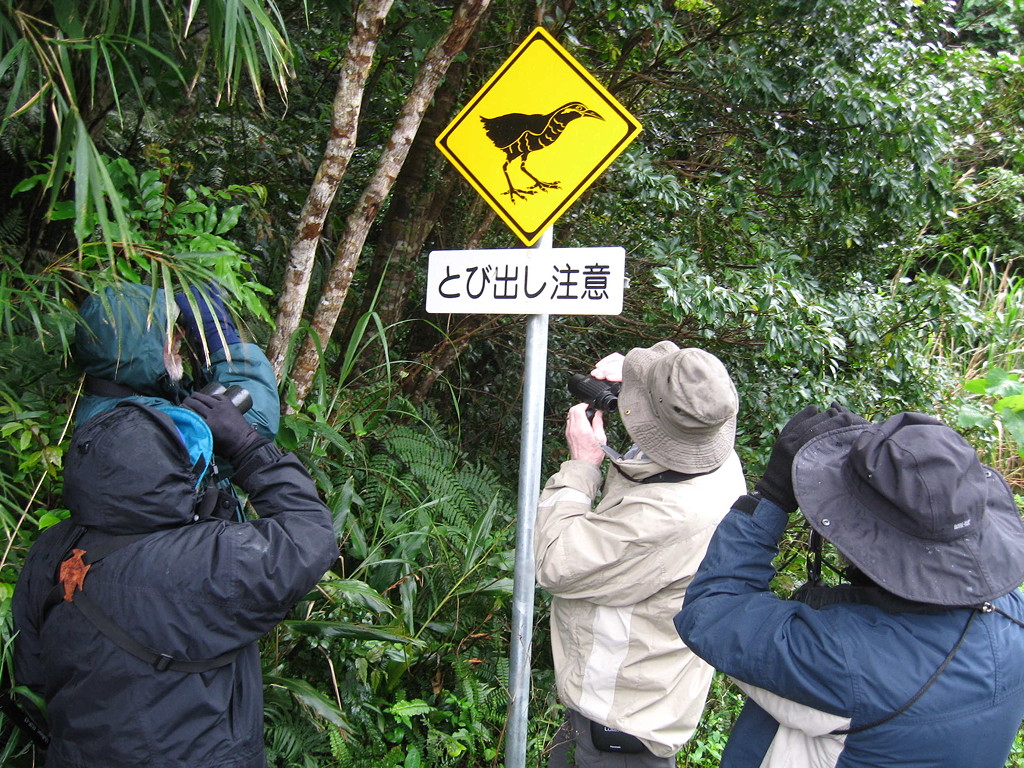 The Oku River Valley on the west side of Oku village (as you drive west towards Cape Hedo, take the small road on the left just as you go out of the village at the bottom of the hill on Route 58).
The Oku River Valley on the west side of Oku village (as you drive west towards Cape Hedo, take the small road on the left just as you go out of the village at the bottom of the hill on Route 58).
Minshuku Miyagi Birds can often be heard around the minshuku which is next to the river at the east end of Oku village. If you stand on the bridge right at the very east end of the village sooner or later rails are likely to start calling nearby. They have been known to roost in the minshuku garden, and can sometimes be heard calling at night from the forest on the far side of the main road.
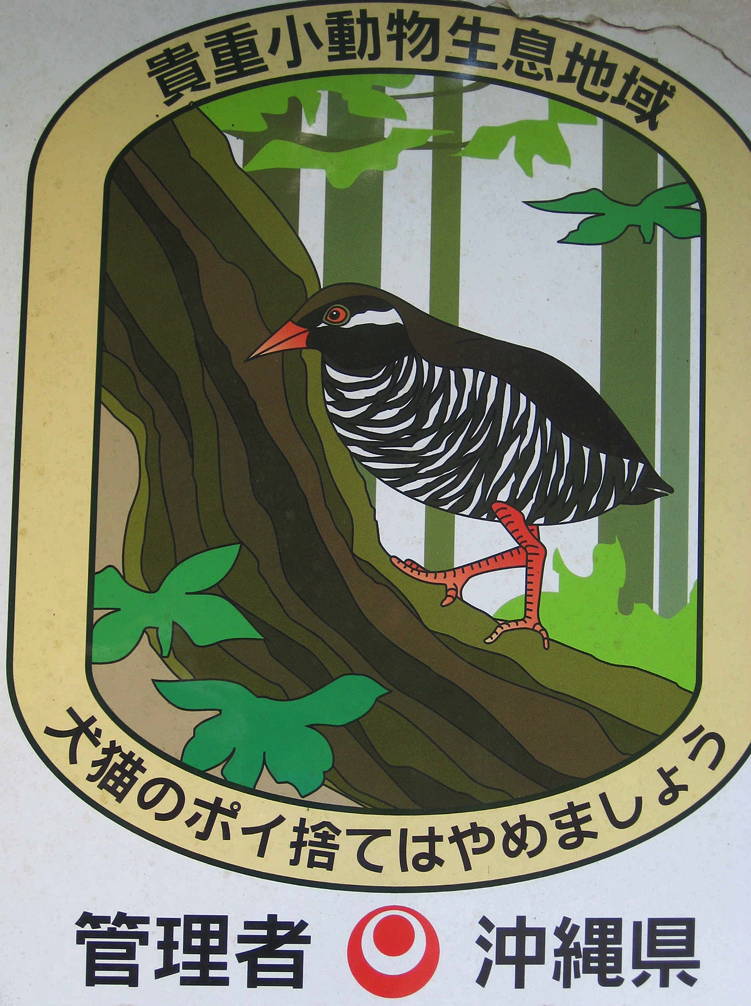 Okuni-rindo and Terukubi-rindo These forest tracks whcih turn off Route 2 are excellent for a wide range of species. Maps and leaflets showing these roads can be found at the Yanbaru Wildlife Conservation Centre, which is signposted on the main road in Kunigami village.
Okuni-rindo and Terukubi-rindo These forest tracks whcih turn off Route 2 are excellent for a wide range of species. Maps and leaflets showing these roads can be found at the Yanbaru Wildlife Conservation Centre, which is signposted on the main road in Kunigami village.
Yanbaru Discovery Centre The area around the centre and beside the road between the centre and Route 2, despite being a well-used road, is a good area to watch as birds are often seen feeding at the road side.
Ada Village The river mouth, the cemetary and the mangroves on the south side of the river in the village (about two kilometres east of Ada Garden Hotel) is a favoured place. Drive slowly and carefully around the many roads in the area at dawn and just before dusk when rails (and other birds) sometimes dart across the road.
http://www.mapfan.com/en/en_m.cgi?MAP=E128.19.3.3N26.44.26.3&ZM=7
http://www.mapfan.com/en/en_m.cgi?MAP=E128.17.36.6N26.50.10.8&ZM=10
http://www.mapfan.com/en/en_m.cgi?MAP=E128.19.9.1N26.44.19.2&ZM=10
Benoki Dam area
http://www.mapfan.com/en/en_m.cgi?MAP=E128.15.49.2N26.46.55.7&ZM=7
Amami Woodcock: Although most likely to be encountered on Amami-Oshima, its main range, it does also occur in the forests of Yanbaru, where it is scarce. Look for it at night while searching for rails.
Japanese (Collared) Scops Owl: Hard to see, could they can be anywhere in the forest. They occasionally sit on roadside guard rails around Oku village, along the Oku river valley or Yanbaru Manabi no Mori at nighttime.
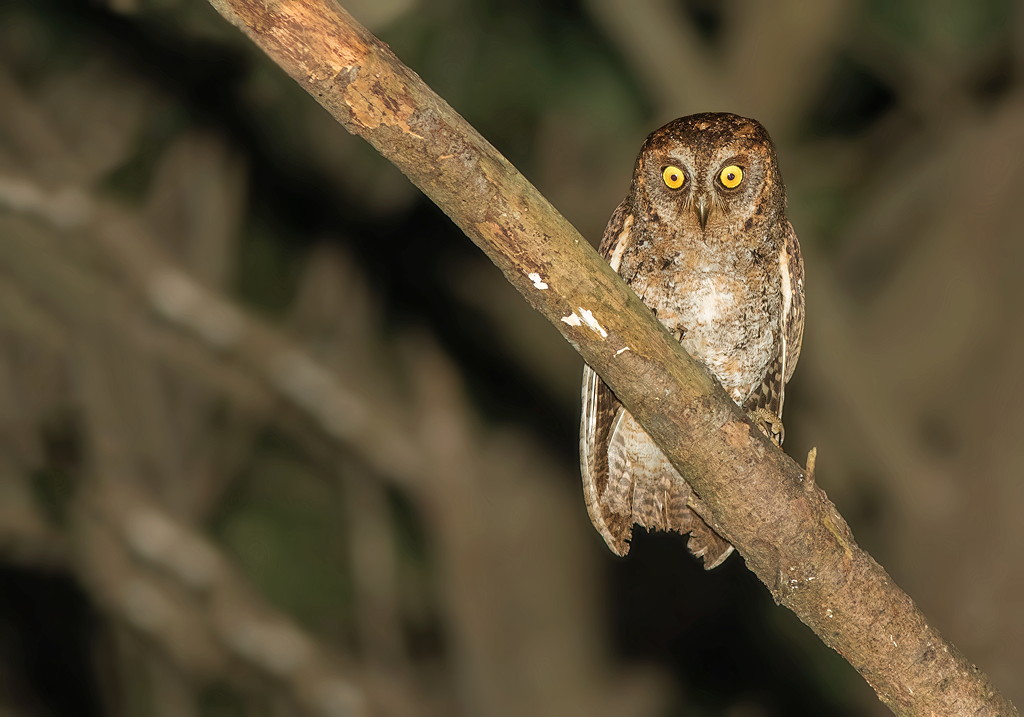 Ryukyu Scops Owl: Often heard, and sometimes even seen (but not guaranteed!) during night drives
Ryukyu Scops Owl: Often heard, and sometimes even seen (but not guaranteed!) during night drives
Pryer’s Woodpecker: This rare woodpecker, endemic to the northern third of Okinawa main island, occurs in mature forested habitat — and in Yanbaru, there's no shortage of evergreen broad-leaf forest habitat in which to search for it!.
Important areas to check for it are along the Okuni-rindo and Terukubi-rindo (forest tracks) off Route 2, and also in the Oku area, along the Yona River, at the Hiji Falls car park and along the hiking trail there, and around the various reservoirs in the region.
Either park yoru vehicle car and walk along the road — listen for any woodpeckers tapping or calling (the call is a tern-like "kit kit kit kit") — or drive slowly and listen for calls in trees close to the road.
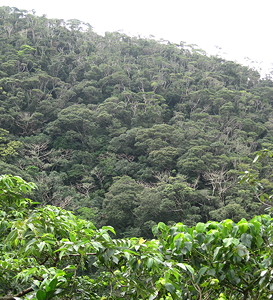 Ryukyu Minivet: Anywhere in the forests in the north of Okinawa, such as at the Yanbaru Nature Centre or Kunigami Forest Park there is a chance to see this speceis. Tip: Stand in an open area such as a car park or overlook and wait until birds fly overhead, especially very early morning when they are searching for food in the forest.
Ryukyu Minivet: Anywhere in the forests in the north of Okinawa, such as at the Yanbaru Nature Centre or Kunigami Forest Park there is a chance to see this speceis. Tip: Stand in an open area such as a car park or overlook and wait until birds fly overhead, especially very early morning when they are searching for food in the forest.
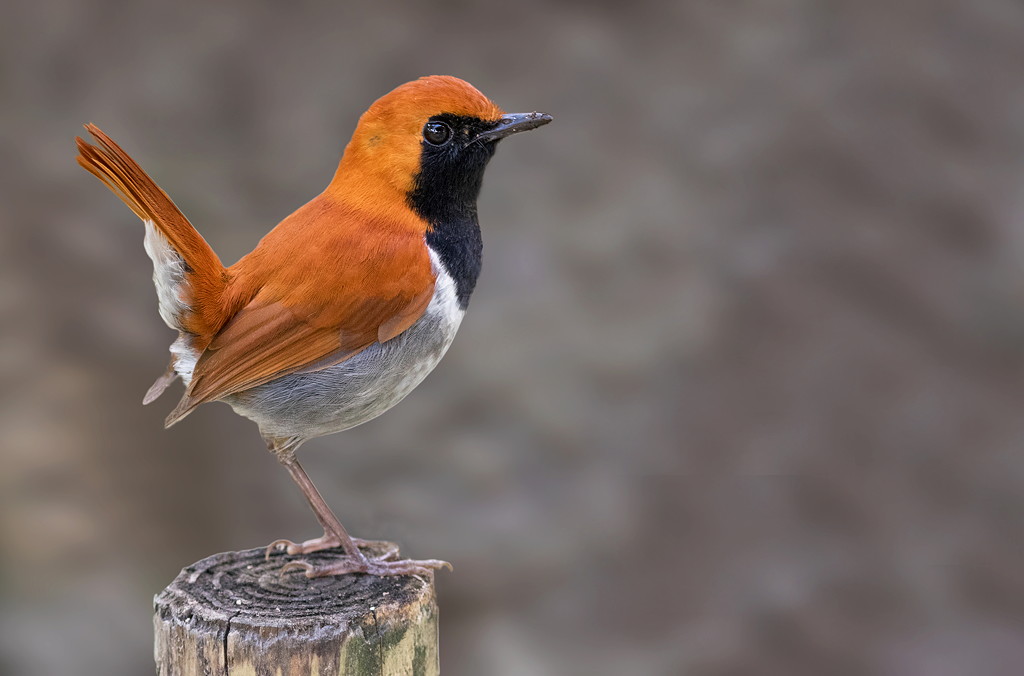 Okinawa Robin: Although this delightful songster is commonly heard singing early in the morning inside the forest, it is not always easy to see. It can sometimes be seen around the entrance building/car park at Hiji Falls, near Hentona village, but if you are out right at dawn driving the roads they often emerge at the roadside (Route 2 and forest roads).
Okinawa Robin: Although this delightful songster is commonly heard singing early in the morning inside the forest, it is not always easy to see. It can sometimes be seen around the entrance building/car park at Hiji Falls, near Hentona village, but if you are out right at dawn driving the roads they often emerge at the roadside (Route 2 and forest roads).
Cinnamon Bittern: The traditional site for this species is at Kijyoka, just south of Kunigami/Hentona. Here, marshy fields used for growing irises and rushes provide the right kind of habitat, but bittern numbers have declined and very few of this attractive bittern remain in northern Okinawa now.
Other species to look for here include Greater Painted Snipe, Common Snipe, White-breasted Waterhen, Grey-faced Buzzard and Scaly-breasted Munia.
Map: 26.707036, 128.149108
Accommodation:
Minshuku Miyagi, Oku Village Tel: 0980-41-8383 Map: 26.840772, 128.291299
This small, welcoming Japanese-style accommodation is situated at the east end of Oku Village, close to the bridge over the Oku River. It is reasonably priced and the owners serve delicious locally produced and locally caught food in a very casual environment. Miyagi-san, the owner, becomes very talkative during the evening after a beer or two! It's a good place to stay if you need to brush up on your Uchinaguchi, the dialect of northern Okinawa! Listen for rails, owls and Ryukyu Fruit Bat calling nearby after dark.

Yanbaru Discovery Centre (Yanbaru Manabi no Mori やんばる学びの森)
Tel: 0980-41-7979 Map: 26.724068, 128.264851 http://www.atabii.jp
Located about 4 km to the south of Route 2, it has extensive views over the forest as it is set in the middle of nowhere! There are walking trails nearby, and the three main target species: Okinawa Rail, Pryer's Woodpecker and Okinawa Robin can be found in the immediate vicinity Plus, after dark, Ryukyu Scops Owl and Japanese Scops Owl can also sometimes be seen or at least heard.
Ada Garden Hotel Tel: 0980-41-7070 https://ada-hotel.net
This hotel offers a touch of luxury in rail-land, with pleasant, en suite rooms. From your room in the middle of the night you can often hear the Okinawa Rail's excited and descending kik kik kik kik calls from the nearby forest!
Hotel Kunigami Tel: 0980-41-2115
This small budget hotel, owned by Sakihama-san, located in Kunigami Village, offers a Western-style breakfast.
Minshuku Saji Tel: 0980-41-7676
This small minshuku is situated in Ada Village.
Sites:
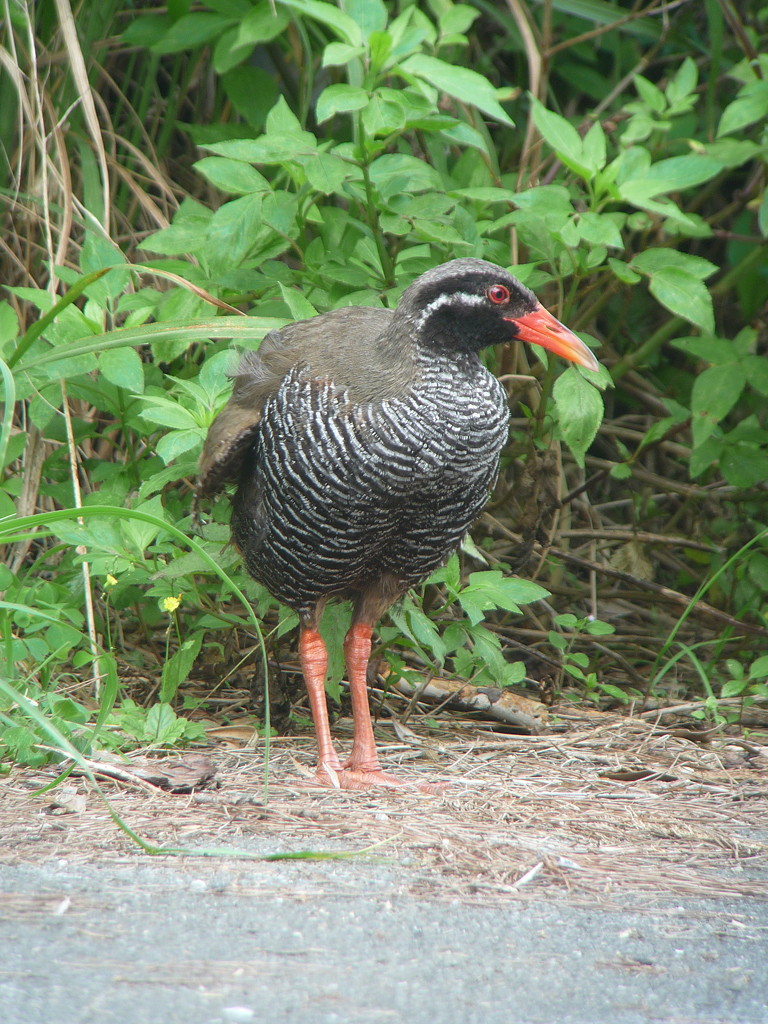 Yanbaru Wildlife Conservation Center: Tel: 0980-50-1025 Map: 26.728197, 128.179138
Yanbaru Wildlife Conservation Center: Tel: 0980-50-1025 Map: 26.728197, 128.179138
This visitor centre in Kunigami Village has informative and helpful staff and shows a video of Okinawa Rail and other Yanbaru wildlife.
Hiji Falls: Map: 26.719251, 128.178780
Stand in the car park and listen for Pryer's Woodpecker calling/drumming
Also early in the morning Okinawa Robin can sometimes be seen hopping around (or even under) the entrance building, or anywhere along the boardwalk and hiking trail to the falls.
Among the leaves along the trail, look for the Ryukyu Black-breasted Leaf Turtle, the endemic forest turtle of the Ryukyu Islands.
Japanese Woodpigeon can be seen here, as well as Japanese Paradise Flycatcher, Pacific Swallow and Ryukyu Minivet. During the winter Grey-faced Buzzard can often be seen soaring overhead.
There is an entrance fee for the trail through the forest. This hike takes about an hour to the falls.
Kijyoka:
The wet fields at Kijyoka 喜如嘉 make it a good area to look for a range of wading birds: Wood Sandpiper, Common Sandpiper and Green Sandpiper, Long-toed Stint and sometimes Temminck's Stint, egrets, as well as Cinnamon Bittern, White-breasted Waterhen, and snipe. Greater Painted Snipe is also a winter visitor here.
Cape Hedo:
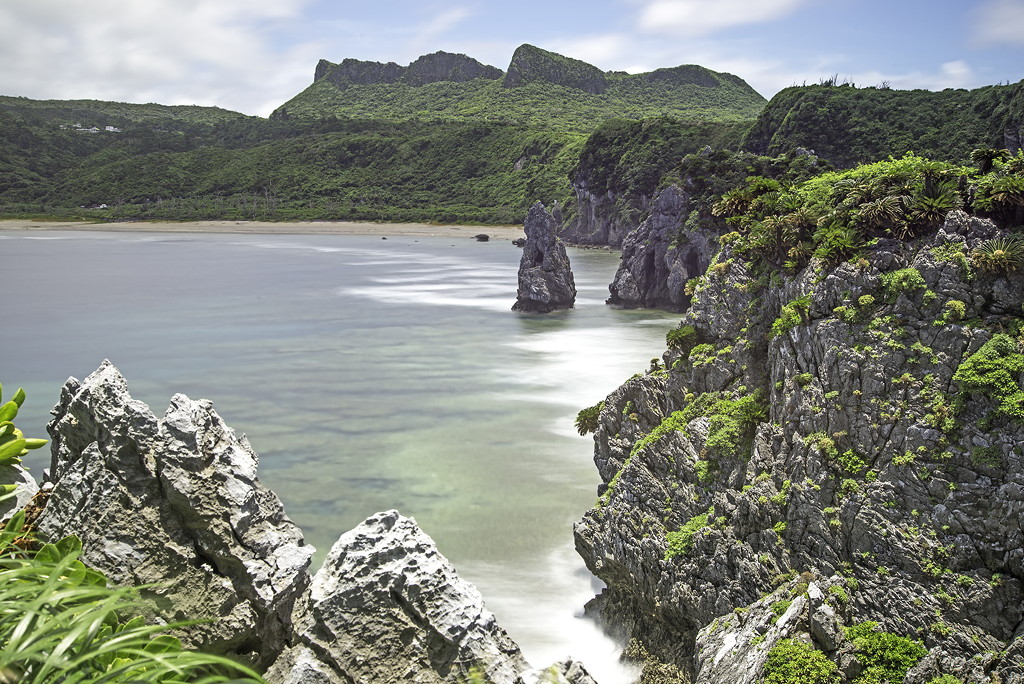 The northernmost tip of the island (Cape Hedo or Hedo Misaki) is worth a visit to look for seabirds offshore — Streaked Shearwater sometimes occur, and terns such as Black-naped Tern and Roseate Tern may be present. If you are very lucky during the winter months you might even see a Humpback Whale breaching offshore [If whales are your thing, then while in Okinawa make a side trip out to Zamami in the Kerama Islands. There are regular excursions from Zamami to watch Humpback Whales]. Eastern Blue Rock Thrush is rarely far away during a walk around this popular sightseeing spot. Toilet facilities are available here.
The northernmost tip of the island (Cape Hedo or Hedo Misaki) is worth a visit to look for seabirds offshore — Streaked Shearwater sometimes occur, and terns such as Black-naped Tern and Roseate Tern may be present. If you are very lucky during the winter months you might even see a Humpback Whale breaching offshore [If whales are your thing, then while in Okinawa make a side trip out to Zamami in the Kerama Islands. There are regular excursions from Zamami to watch Humpback Whales]. Eastern Blue Rock Thrush is rarely far away during a walk around this popular sightseeing spot. Toilet facilities are available here.
© 2021 Mark Brazil & Chris Cook
Last updated: 20210925
